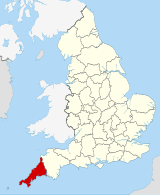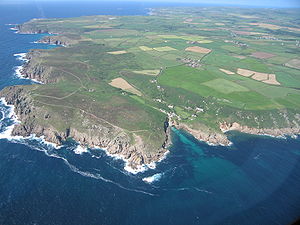Portal:Cornwall
  Cornwall (/ˈkɔːrnwɔːl, -wəl/; Cornish: Kernow; Cornish pronunciation: [ˈkɛrnɔʊ]; or [ˈkɛrnɔ]) is a ceremonial county in South West England. It is recognised by Cornish and Celtic political groups as one of the Celtic nations, and is the homeland of the Cornish people. The county is bordered by the Atlantic Ocean to the north and west, Devon to the east, and the English Channel to the south. The largest settlement is Falmouth, and the county town is the city of Truro. The county is rural, with an area of 1,375 square miles (3,562 km2) and population of 568,210. After Falmouth (23,061), the largest settlements are Penzance, Newquay, St Austell, and Truro. For local government purposes most of Cornwall is a unitary authority area, with the Isles of Scilly having a unique local authority. The Cornish nationalist movement disputes the constitutional status of Cornwall and seeks greater autonomy within the United Kingdom. Cornwall is the westernmost part of the South West Peninsula. Its coastline is characterised by steep cliffs and, to the south, several rias, including those at the mouths of the rivers Fal and Fowey. It includes the southernmost point on Great Britain, Lizard Point, and forms a large part of the Cornwall National Landscape. The national landscape also includes Bodmin Moor, an upland outcrop of the Cornubian batholith granite formation. The county contains many short rivers; the longest is the Tamar, which forms the border with Devon. (Full article...) Selected articleMV Darlwyne was a pleasure cruiser, a converted Royal Navy picket boat, that disappeared off the Cornish coast on 31 July 1966 with its complement of thirty-one (two crew and twenty-nine passengers, including eight children). Twelve bodies and a few artefacts were later recovered, but the rest of the victims and the main body of the wreck were never found. Built in 1941, after ending its naval service in 1957, Darlwyne was used as a private cabin cruiser, first on the River Thames and later in Cornwall, where it became a commercial passenger boat, despite being unlicensed for such work. It underwent considerable structural modifications, including the removal of its original watertight bulkheads and the conversion of its aft cabin into a large open cockpit. These changes adversely affected its seaworthiness. Surveyors' reports in 1964 and 1966 indicated that Darlwyne was unfit for the open sea; furthermore, it carried no radio or distress flares, and its lifesaving aids were rudimentary. By 1966, Darlwyne was in the ownership of John Barratt of Penryn in Cornwall. The fatal voyage was arranged when the boat's skipper, Brian Bown, agreed to take a group of guests from the Greatwood guest house in Mylor on a sea trip to Fowey. On the morning of 31 July, the outward voyage was completed without mishap, but the weather subsequently deteriorated. Bown disregarded advice to remain in Fowey harbour, and shortly after 4:00 pm began the return trip to Mylor. An unconfirmed sighting at around 6:00 pm placed the boat, in worsening conditions, in the vicinity of Dodman Point, a prominent coastal feature. Following its failure to arrive at Mylor the alarm was raised early on 1 August, and full air and sea searches began at dawn. After the recovery of 12 bodies, searches continued intermittently for several months, without finding traces of the vessel. A Board of Trade enquiry into Darlwyne's loss placed the main blame on Barratt and Bown for allowing the vessel to go to sea in an unsafe and unprepared condition. Bown was lost in the disaster; Barratt was censured and ordered to contribute £500 to the cost of the enquiry. The Board's report exposed the laxity with which boat licensing regulations were being administered, and led to stiffer penalties for non-compliance, but there were no immediate regulatory changes, and no criminal proceedings were recommended. In April 1967 a memorial screen, listing the names of the 31 dead, was dedicated in Mylor church at a special service led by the Bishop of Truro. In 2016, on the 50th anniversary of the sinking, divers found an anchor and other debris at a location close to Dodman Point, which they stated were in all probability Darlwyne relics. (Full article...)Selected biographyVice-Admiral William Bligh FRS (9 September 1754 – 7 December 1817) was a British officer in the Royal Navy and a colonial administrator. He is best known for the mutiny on HMS Bounty, which occurred in 1789 when the ship was under his command. The reasons behind the mutiny continue to be debated. After being set adrift in Bounty's launch by the mutineers, Bligh and those loyal to him stopped for supplies on Tofua, losing a man to natives. Bligh and his men reached Timor alive, after a journey of 3,618 nautical miles (6,700 km; 4,160 mi). On 13 August 1806, Bligh was appointed Governor of New South Wales in Australia, with orders to clean up the corrupt rum trade of the New South Wales Corps. His actions directed against the trade resulted in the so-called Rum Rebellion, during which Bligh was placed under arrest on 26 January 1808 by the New South Wales Corps and deposed from his command, an act which the British Foreign Office later declared to be illegal. He died in London on 7 December 1817. (Full article...)
Did you know?
Selected quoteSelected picture
General imagesThe following are images from various Cornwall-related articles on Wikipedia.
WikiProjects
Related portalsTopicsHistory
Geography
Politics
Economy and demographics
Culture
SubcategoriesRecognised content
Featured articlesMain page featured articlesFeatured listsGood articles
Former good articlesIn the News articlesThings you can do'
Associated WikimediaThe following Wikimedia Foundation sister projects provide more on this subject:
Wikipedia in CornishDiscover Wikipedia using portals
| |||||||||||||||||||||||||||||||



































































